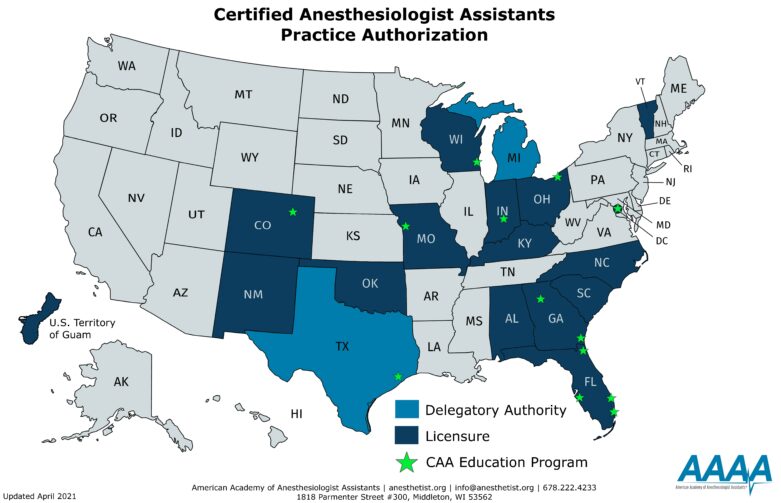In an attempt to be thorough, I’m including information here about Anesthesia Assistants. I do this because I’m a researcher by nature, and if you’re interested in practicing anesthesia, this one just may come up.
But let me be clear that Anesthesia assistants are not on equal footing with CRNAs, and (maybe because of this) are unable to practice in all 50 states.
The title of anesthesia assistant arose in 1969 due to a shortage of qualified individuals in the field of anesthesiology. It remains a small, dynamic and evolving profession. Today, they number over 1,800 practicing in the US (compared to the more than 44,000 CRNAs practicing nationwide).
Becoming an anesthesia assistant may or may not be the right fit for you, depending on your priorities.
Why you might consider becoming an anesthesia assistant
If you are untrained as a nurse (you have a bachelor’s degree in something non-nursing and you’re looking for the fast-track route to increasing your income (while working in the medical field), AND you are willing to limit yourself to living in the states mentioned below, this track may be a good fit for you.
Salary
According to Salary.com, the average anesthesiologist assistant now makes $163,193. The salaries range between $132,951 and $201,357.
Why you may not want to become an anesthesia assistant
However, if you’re looking for autonomy and the respect of your peers, you may be disappointed if you choose this route.
Anesthesia is a unique profession because there are essentially 3 different angles you can come from that lead you to the same general daily practices.
You can (A) go to medical school and get master’s level training in anesthesia.
I tend to feel that just as Goldilocks in the famous children’s story finally found the chair, the bed and more economical for the hospital who is hiring the CRNA. It’s also well-documented that patient outcomes are the same whether an anesthesiologist or a CRNA is the one providing care. The same cannot be said for the anesthesia assistant (which is why they need constant supervision).
Here are some reasons you may regret your decision to become an anesthesia assistant (if, indeed, that is what you end up choosing):
- You will never be able to practice anesthesia independently (no autonomy).
- You will be considered a physician extender (you do much of the work while the anesthesiologist hangs out in the lounge).
- You are confined to live in one of the states listed below.
- You will not have the respect of CRNAs.
- You will lack a strong medical background that many of your peers find essential to the profession.
- You would not be eligible to practice in the military
AAs must complete more than two years of training in an accredited master’s degree program.
Where You Can Work
AAs are part of an Anesthesia Care Team providing care under the medical direction of a qualified anesthesiologist. Most anesthesia assistants work in outpatient ambulatory centers, teaching institutions, and private hospitals.
Where You Can Practice
Anesthesiologist Assistants can now work in additional states and are no longer able to work in others.

AAs can practice based on a license, regulation, and/or certification in the following areas:
- Alabama
- District of Columbia
- Florida
- Georgia
- Kentucky
- Missouri
- New Mexico (university hospital settings)
- North Carolina
- Ohio
- Oklahoma
- South Carolina
- Vermont.
AAs can practice through physician delegation (i.e. the anesthesiologist delegates tasks to an AA) in these states:
- Colorado
- Michigan
- New Hampshire
- Texas
- West Virginia
- Wisconsin.
AAs can practice throughout the country by working for the federal government. The Department of Veterans Affairs and the Department of Defense hire AAs to practice under the TRICARE program.
Becoming an Anesthesia Assistant
To become an anesthesia assistant, you would need to complete a master’s degree from one of 7 anesthesiologist assistant programs in the United States. The accredited AA programs are found across the country at the following sites:
- Case Western Reserve University, Cleveland, Ohio
- Case Western University, Houston, TX
- Emory University, Atlanta, Georgia
- Nova Southeastern University, Ft. Lauderdale, Florida
- Nova Southeastern University, Tampa, Florida
- South University, Savannah, Georgia
- The University of Missouri, Kansas City, Missouri.
Before you apply, you’d need to have a bachelor’s degree with courses typical of a premedical curriculum. Prerequisites for admission include undergraduate coursework in biology, biochemistry, chemistry, organic chemistry, mathematics, physics, and English. A GPA greater than 3.0 on 4.0 scale is expected.
Programs entail 24 to 28 months of study and clinical work. Entering class sizes range from 8 to 50 students depending on the particular program.
Graduates of AA programs are members of an exclusive group. Combined, all the US programs graduate roughly 120+ students per year. Programs report a stellar 100% pass rate on the certifying exam administered by the National Commission for Certification of Anesthesiologist Assistant.
Continuing Education
Being an AA requires a dedication to lifelong learning. AAs must complete 40 hours of continuing medical education credits every two years to maintain certification. In addition, every six years you must successfully pass the Examination for Continued Demonstration of Qualifications administered by the National Board of Medical Examiners.
You can learn more about a career as an anesthesia assistant at the American Academy of Anesthesiologist Assistants (AAAA) website.
Did you find an error on this page? Please report it here